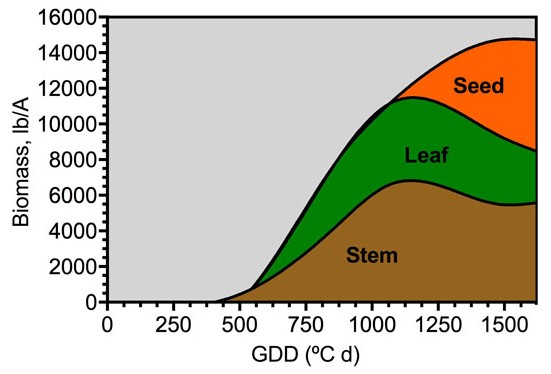By Ignacio A. Ciampitti
The latest USDA-National Agricultural Statistics Service, Kansas Crop Progress and Condition report classified 67% of the soybean crop to be in good to excellent condition. Overall, only 4% of all soybeans in Kansas are dropping leaves with most of the crop entering into the “seed-filling” period.
The weather conditions expected in the next coming weeks will be critical for soybeans (mostly for early-planted crops) to define not only the final attainable seed weight, but also the final number of pods and seeds per pods (or seeds per unit area). The 8 to14-day weather outlook from NOAA indicates a normal to slightly above-normal probability for precipitation in the central and eastern parts of Kansas, but a below normal probability for the western region, potentially shortening the seed filling duration due to stress conditions. There is still quite a bit of yield to be defined in the next month of growth for soybeans. Relative to the final total yield (biomass) at harvest, soybeans only accumulate 60-70% until R5 stage, with the other 30-40% accumulated during the seed filling (R5-R7), lasting 30-40 days (see Figure 1, initial seed filling around 1000 °C d).

Figure 1. Soybean biomass accumulation from planting to maturity, seed filling period from 1000 °C d to maturity. Figure prepared by Ignacio Ciampitti and Guillermo Balboa, K-State Research and Extension.
Soybean dry matter accumulation and water changes during seed-filling
Soybeans will reach final maturity with high seed water content, moving from 75-80% (R6) to around 50% (R7) from beginning of seed filling until final maturity (Figure 2). Final maturity is defined as the formation of the black layer in the seeds. The process of seed dry matter accumulation and moisture changes will depend on the maturity group (affecting the length of the season), planting date, and weather conditions experienced during the latter part of the reproductive phase.
Changes in the water content during the seed-filling process (Figure 2) were previously described in our “
Soybean Growth and Development” poster. As described for corn, seed water loss for soybeans can also divided in two phases: 1) before “black layer” or maturity, and 2) after black layer.
Figure 2. Soybean seed filling process from full seed to full maturity. Photo and infographic prepared by Ignacio Ciampitti, K-State Research and Extension. Taken from Soybean Growth and Development.
The overall contribution of seed weight to final yield can be studied by evaluating changes in seed weight during the seed filling period, building a dataset portraying the rate and duration of the changes in seed filling (Figure 3).
In the example presented below, overall seed filling lasted more than one month (37 days) until black layer (no changes in seed weight) was achieved. The graph of seed filling provides a visual of the overall rate, increase in seed weight per day, and the duration of the seed filling (Figure 3). With this information, we can improve our understanding of potential impacts of stress conditions during this time of the season for soybeans. In the example presented in Figure 3, you can see the impact that decreasing the effective duration of the seed filling period has in the final yield. When the duration is reduced by one week (from 37 to 30 days), the attainable yield dropped from 61 to roughly 50 bushels per acre.
Potential impacts on leaf green area imposed by insects, diseases, hailstorms, and any other potential abiotic stress conditions (extremely high temperature, cloudy days, lack of timely precipitation, and early frost) impacting the crop during the coming weeks will negatively affect the seed filling conditions for soybeans.
Figure 3. Soybean seed weight changes from beginning of seed filling (R5) to full maturity. Photo and infographic prepared by Ignacio Ciampitti and Santiago Tamagno, K-State Research and Extension.
In summary, much of the yield for the Kansas soybean crop is still to be determined in the coming weeks. Scout your fields for any potential issues impacting overall plant health to maximize the chances of maintaining yields.